
11 minute read
ALL ALASKA SWEEPSTAKES
“Togo- Most traveled dog in Alaska - Champion trophy winner in Nome - Record of longest and fastest run in Serum Drive,” with 3-time Sweepstakes Champion Leonhard Seppala.
Advertisement
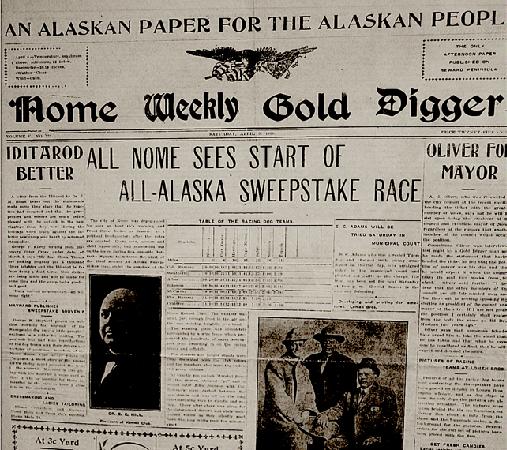
All Nome turned out for the Great Race.
“We all know what an important part dogs have contributed to the development of Alaska, how dependent we are up here on them for transportation. I propose that we establish a Kennel Club, the purpose of which will be to improve the strains of Alaskan dogs, and to better their conditions. The Annual All-Alaska Sweepstakes races...will serve to prove which dogs are best. I predict that dog racing in Alaska will prove as popular a sport as horse racing in Kentucky.”
With these words at the Board of Trade saloon in the winter of 1907, the Nome lawyer and dog fancier Albert Fink and a few friends set in motion the creation of the Nome Kennel Club, which would be the first to formalize the rules for racing dogs, founded on the same principles as jockey clubs. Albert Fink served as the first President.
The first race, a 408-mile route to Candle and return, held in the spring of 1908, was won by musher John Hegness driving Albert Fink’s team and winning the purse of $10,000. The time for Hegness was 119 hours, 15 minutes, and 22 seconds. The time for popular Nome musher “Scotty” Allan was 120 hours, 7 minutes, and 52 seconds. This close finish for such a rich purse guaranteed the future popularity of the race!
There were, however, extenuating circumstances: A two-hour interval between starting teams would prove disastrous when a storm forced the leaders to wait at a checkpoint while the following teams caught up, and the next year the starting interval was changed to two minutes. Albert Fink would later gain fame as the defense attorney for Illinois Senator William Lorimer’s bribery trial, and as the special tax lawyer who gave the summation for the defense in the tax evasion trial of Chicago mobster Al Capone. In both cases the defendant was found guilty.
The course set for the All Alaska Sweepstakes was a tough one, traversing the width of the remote Seward Peninsula from south to north and back again. Esther Birdsall Darling described the trail in her promotional booklet and Official Souvenir History, The Great Dog Races of Nome: "The route varies consistently - from hour to hour - from narrow passage between towering ice hummocks of the Bering Sea to wide plains of unbroken snow; from the steep slopes of Topkok Hill, to the desolate, storm-swept waste of Death Valley; from the pleasant winding road through wooded Council district, to the trackless and treacherous ice on rivers and lakes."
Archdeacon of the Yukon Hudson Stuck further explained the country in his 1914 book, 'Ten Thousand Miles with a Dogsled:' "Traveling, like so many other things, is very different on the Seward Peninsula. The constant winds beat down and harden the snow until it has a crust that will carry a man anywhere."
A little later, after describing the local meteorological peculiarities, he continues: "So a striking difference in travel at once manifests itself; in the interior all the snow is soft except on a beaten trail itself, while in the Seward Peninsula all the snow is alike hard. The musher is not confined to trails-he can go where he pleases; and his vehicle is under no necessity of conforming in width to a general usage of the country-it may be as wide as he pleases. Hence the hitching of dogs two and three abreast; hence the sleds of twenty-two, twenty-four, or twenty-six inches in width. My tandem rig aroused the curiosity of those who saw it."
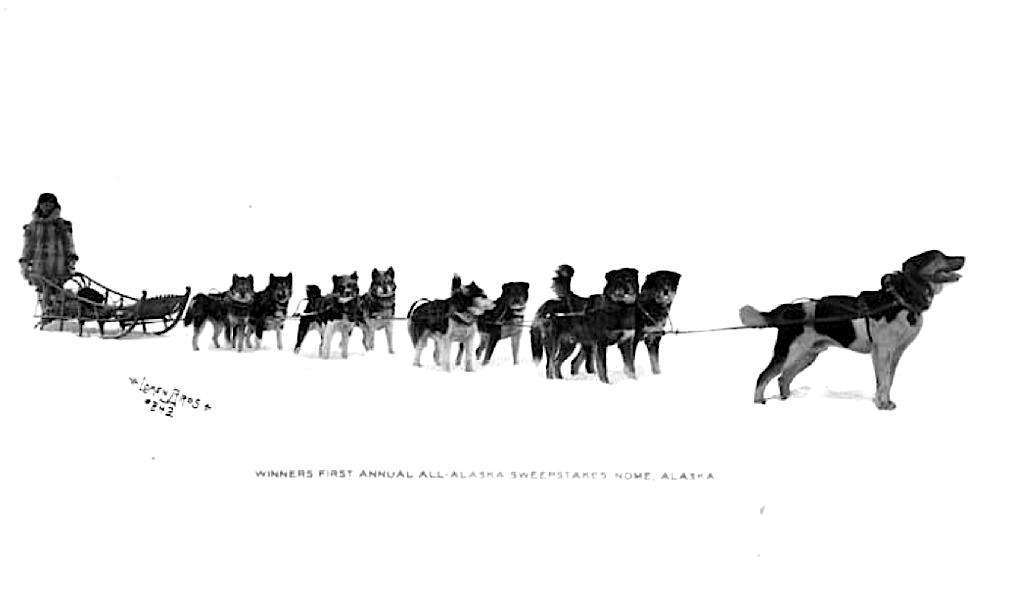
Winners, First Annual All-Alaska Sweepstakes, Nome, Alaska. 1908, John Hegness, driver.
[Lomen Bros. photograph. Univ. of Alaska Fairbanks, Seiffert Family Photographs UAF-1985-122-1115.]

Winner 2nd All Alaska Sweepstakes. Berger's entry #1, Scotty Allan, driver. April 1, 1909.
[Lomen Bros. photograph. University of Washington Libraries, Special Collections. PH Coll 328.249]
And of the trail from Candle to Council the Archdeacon wrote: "For a while there would be travel such as one sees in children's picture-books, where the man sits in his sled and cracks his whip and is whisked along as gaily as you please - such travel as I had never had before; but there was no pleasure in it - the wind saw to that."
Allan Alexander “Scotty” Allan
Allan Alexander “Scotty” Allan wrote in his autobiography 'Gold, Men and Dogs' (1931, G.P. Putnam's Sons), "It was great fun winning a race. No matter how much you suffered you felt all right in the end; the same applied to the dogs. The toughest job of all was to go through with a race which you lost. You not only had the disappointment, but the dogs always seemed to know that things hadn't gone right."
Scotty tells of the harrowing 1910 race when he literally "fell off a mountain," when a snow ledge gave way beneath his team and he and his team rolled over two hundred feet down a nearly vertical drop, but they gathered themselves and finally arrived at the finish line with "five dogs hitched, two in the sled, and three tied behind.”
Scotty later wrote that the last three and one half miles of the race were a total blank, "I never remembered any of it afterwards." And he didn't remember tying the three loose dogs to his sled.
Alaskan author Barrett Willoughby's novel The Trail Eater: A Romance of the All Alaska Sweepstakes (1929, G.P. Putnam's Sons) featured a hero based on the real Scotty Allen. The foreword to her book captures the legend of the race: "In this novel of love and reckless adventure I tell of the gold town of Nome in the heyday of its glory--rich, careless, luxurious, and ugly. Nome in evening clothes and on the trail. Nome where the wolf-dog was king, and fortunes were lost, and gold mines were won on strings of racing malemutes. I tell of the Sweepstakes Trail, and the daredevil drivers who risked their lives on that four-hundred-mile course that is the longest, most hazardous, most cruel--and most fascinating--known to the world of sport. My characters are fictional, but every racing incident is drawn from the colorful career of the champion driver of the All Alaska Sweepstakes--Allen Alexander Allan."
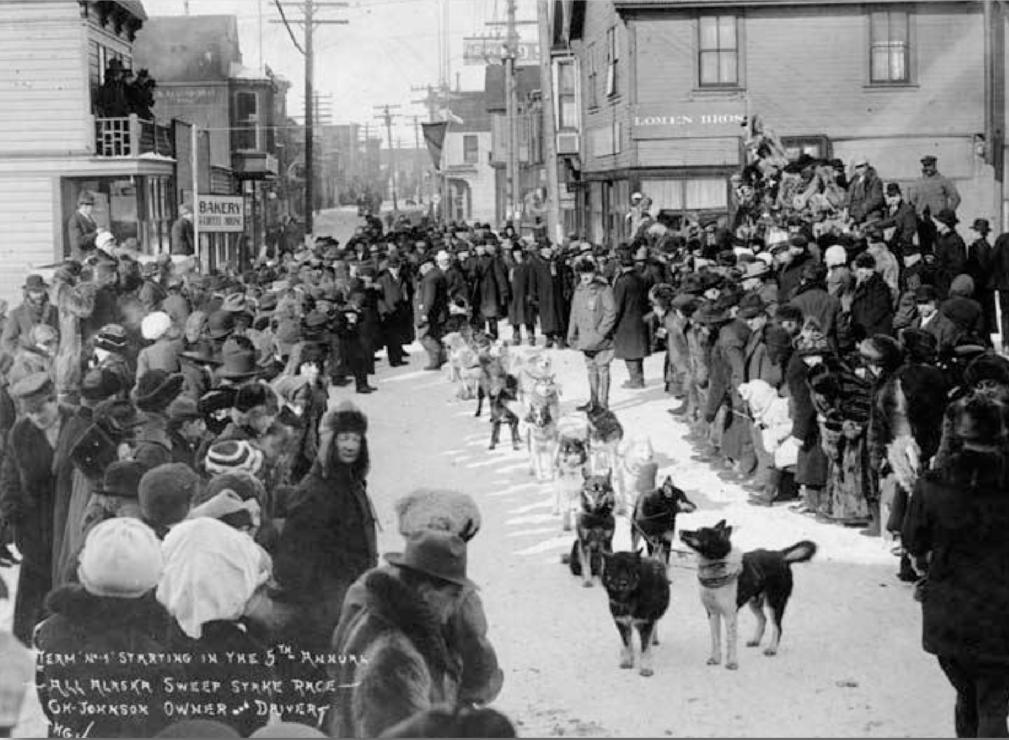
Team No. 1 starting 5th All Alaska Sweepstakes, April 4, 1912. G.H. Johnson, owner/driver.
[Photo by H.G. Kaiser. Dr. Daniel S. Neuman Photographs P307-0313 Alaska State Library]
Willoughby describes the scene at the start of famed race: "In front of the judges' stand racing drivers were already swinging their teams in--lines of superbly trained, lithe-limbed, thinflanked dogs, groomed to a hair and stripped to their twelve-ounce racing harnesses. At every new arrival a cheer burst from the watching crowd, a cheer that was both for the dogs, and for their tense-faced driver standing behind the handlebars, furred, mukluked, with his starting number on a white square sewed to the front and to the back of his parka."
In the 1910 race John “Iron Man” Johnson drove a team for the Scottish nobleman, Fox Maule Ramsay, who had traveled to the Anadyr River area of Siberia and brought back to Nome around sixty of the "thick-coated, prick-eared, tough-footed, swift little foxy-looking dogs," which became the distant forerunners of today's Siberian husky.
Driving a team of these speedy little huskies, with his own blue-eyed Siberian leader Kolyma in front, Johnson set a record in the 1910 race of 74 hours, 14 minutes, and 37 seconds. It was a record which stood until 2008.
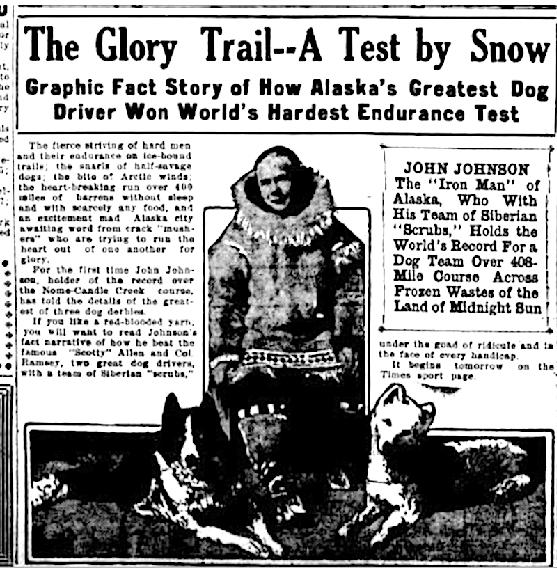
1910 news clipping, “Iron Man” Johnson

John “Iron Man” Johnson’s leader, Kolyma
“King of the Alaskan Trail”
The great dog driver Leonhard Seppala ran his first All Alaska Sweepstakes race in 1914. A legend in his own time, Seppala lost the first race when he miscalculated the trail, nearly losing his team - and his life - over cliffs which rimmed the Bering Sea. Sliding on ice, barely twenty feet from disaster, his freighting leader Suggen, half Siberian and half malemute, clawed his way to safety with a young and inexperienced team scrambling behind him. Later Seppala said, "I don't know what [Suggen] told them, but it worked."
Leonhard Seppala's contributions to the All Alaska Sweepstakes, to dog mushing, and to the development of the Siberian Husky cannot be overstated. In The World of Sled Dogs, author Lorna Coppinger wrote ten years after Seppala's death in 1967, "No dog driver has the status, the reknown, the respect of his colleagues as does Leonhard Seppala."
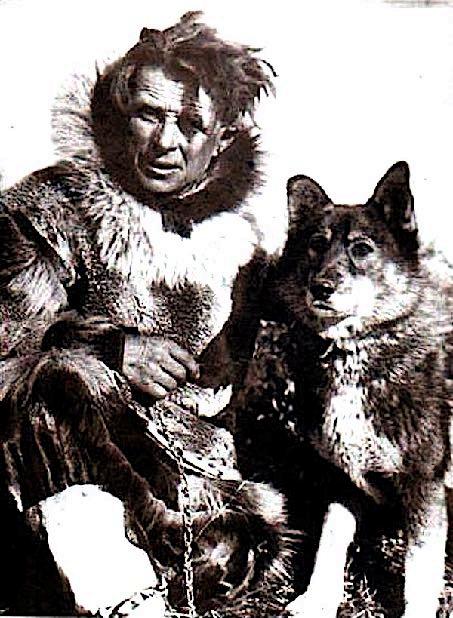
Leonhard Seppala and Togo
In his autobiography, Seppala: 'Alaskan Dog Driver,' Leonhard Seppala writes of standing around the Board of Trade Saloon in Nome, "glancing at Scotty Allan, Fay Dalzene, and John Johnson, and I felt greatly honored if I could speak with them. I thought they were wonderful men and admired their achievements greatly. Little did I think that the day would come when I should be battling my way on the Sweepstakes trail against them! When they came in they would look frostbitten and worn out after the storms and cold they had encountered on the trail, and I envied them their experiences."
Seppala's telling of his second Sweepstakes race is a riveting account, and among the most engaging sections are his encounters with champion dog driver Scotty Allan. Seppala plays a cat-and-mouse game with Scotty Allan, explaining that "Scotty was known for his cunning in dog races, and it was commonly believed that he won his races as much by talking the other fellow out of it as anything else."

Leonhard Seppala often said Togo was his favorite sled dog; named for a Japanese admiral, the tough little Siberian co-led Seppala's team in the 1925 Serum Run.
Seppala did his best to convince Allan that he was no challenge to his bid for the win, and let Allan tell him that he stood a good chance of coming in second. When he was sure Allan was out of sight Seppala urged a little more speed from his team. At the Boston checkpoint the two dog drivers exchanged pleasantries and Allan told Seppala he didn't have to rush to get second place, and as Seppala pulled out he "got a glimpse of Scotty in the window checking up on the condition of my team."
Seppala's dogs were slow to get started, "dragging along and to all appearances were pretty tired and not able to go many miles more; but I was banking on the Siberian traits I knew so well."
Seppala delighted in describing his victorious finish: "Tired as I was, it gave me a thrill which made me forget my fatigue to hear the cannon, and the whistles in Nome from the power plant and the fire stations shrieking their blare of welcome. Great numbers of people were strung along the trail to see the finish, and they shouted their encouragement and approval as I went by. Somehow, I was no longer tired, only glad it was over."
Leonhard Seppala's reputation as “King of the Alaskan Trail” was created by his three consecutive victories in the All Alaska Sweepstakes (1915-17) and his many wins in shorter races, but the intrepid musher would also play a pivotal role in the 1925 Serum Run to Nome, when an outbreak of diphtheria threatened the isolated town. His famous racing leader Togo led Seppala’s team through a blinding blizzard and across the treacherous frozen Norton Sound, saving precious hours in the heroic race against death. ~•~
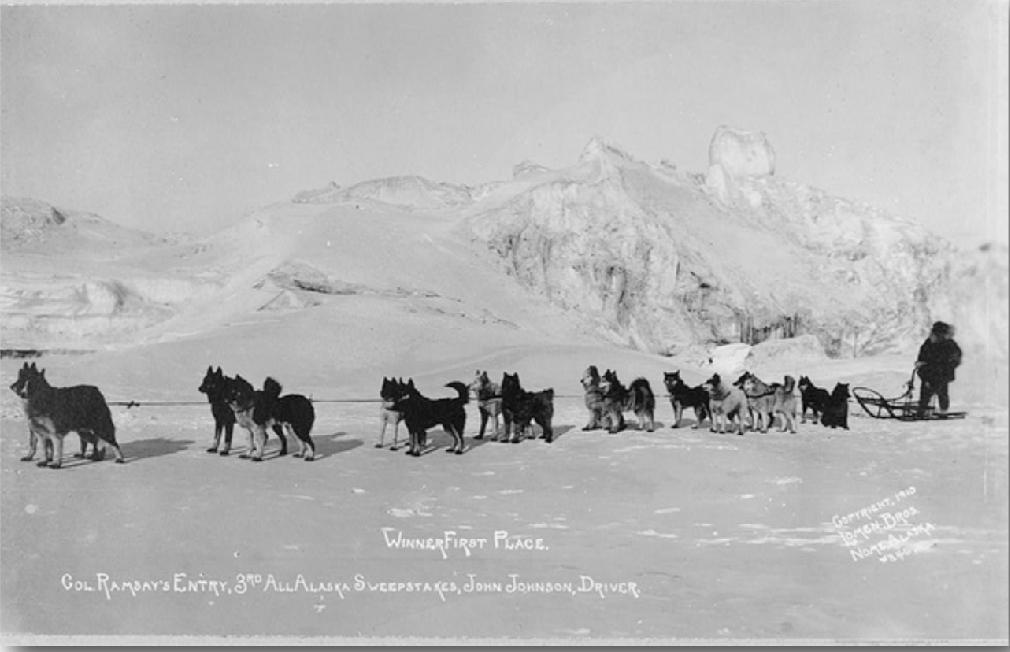
1910 Winner First Place, 3rd All Alaska Sweepstakes, John Johnson, driver.
An excerpt from The Great Dog Races of Nome - Held Under the Auspices of the Nome Kennel Club, Official Souvenir History, by Esther Birdsall Darling, President, 1916:
• ~ • ~ • ~ • ~ • ~ • ~ • ~ • ~ • ~ • ~ • ~ • ~ • ~ • ~ • ~ •






